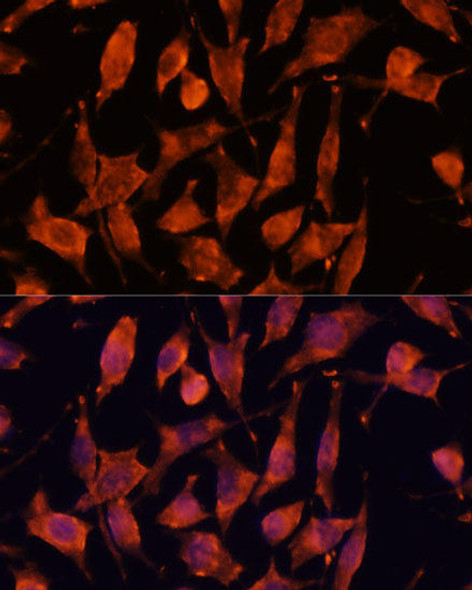Anti-POT1 Antibody (CAB1491)
- SKU:
- CAB1491
- Product type:
- Antibody
- Reactivity:
- Human
- Mouse
- Host Species:
- Rabbit
- Isotype:
- IgG
- Antibody Type:
- Polyclonal Antibody
- Research Area:
- Cell Biology
Frequently bought together:
Description
| Antibody Name: | Anti-POT1 Antibody |
| Antibody SKU: | CAB1491 |
| Antibody Size: | 20uL, 50uL, 100uL |
| Application: | WB |
| Reactivity: | Human, Mouse |
| Host Species: | Rabbit |
| Immunogen: | Recombinant fusion protein containing a sequence corresponding to amino acids 497-634 of human POT1 (NP_056265.2). |
| Application: | WB |
| Recommended Dilution: | WB 1:200 - 1:2000 |
| Reactivity: | Human, Mouse |
| Positive Samples: | A-431, HeLa, DU145, Mouse liver |
| Immunogen: | Recombinant fusion protein containing a sequence corresponding to amino acids 497-634 of human POT1 (NP_056265.2). |
| Purification Method: | Affinity purification |
| Storage Buffer: | Store at -20°C. Avoid freeze / thaw cycles. Buffer: PBS with 0.02% sodium azide, 50% glycerol, pH7.3. |
| Isotype: | IgG |
| Sequence: | TIHH YGCK QCSS LRSI QNLN SLVD KTSW IPSS VAEA LGIV PLQY VFVM TFTL DDGT GVLE AYLM DSDK FFQI PASE VLMD DDLQ KSVD MIMD MFCP PGIK IDAY PWLE CFIK SYNV TNGT DNQI CYQI FDTT VAED VI |
| Gene ID: | 25913 |
| Uniprot: | Q9NUX5 |
| Cellular Location: | Chromosome, Nucleus, telomere |
| Calculated MW: | 60kDa/71kDa |
| Observed MW: | 75kDa |
| Synonyms: | POT1, CMM10, GLM9, HPOT1 |
| Background: | This gene is a member of the telombin family and encodes a nuclear protein involved in telomere maintenance. Specifically, this protein functions as a member of a multi-protein complex that binds to the TTAGGG repeats of telomeres, regulating telomere length and protecting chromosome ends from illegitimate recombination, catastrophic chromosome instability, and abnormal chromosome segregation. Increased transcriptional expression of this gene is associated with stomach carcinogenesis and its progression. Alternatively spliced transcript variants have been described. |
| UniProt Protein Function: | POT1: Component of the telomerase ribonucleoprotein (RNP) complex that is essential for the replication of chromosome termini. Is a component of the double-stranded telomeric DNA- binding TRF1 complex which is involved in the regulation of telomere length by cis-inhibition of telomerase. Also acts as a single-stranded telomeric DNA-binding protein and thus may act as a downstream effector of the TRF1 complex and may transduce information about telomere maintenance and/or length to the telomere terminus. Component of the shelterin complex (telosome) that is involved in the regulation of telomere length and protection. Shelterin associates with arrays of double-stranded TTAGGG repeats added by telomerase and protects chromosome ends; without its protective activity, telomeres are no longer hidden from the DNA damage surveillance and chromosome ends are inappropriately processed by DNA repair pathways. Binds to two or more telomeric single-stranded 5'-TTAGGG-3' repeats (G-strand) and with high specificity to a minimal telomeric single-stranded 5'- TAGGGTTAG-3' sequence. Binds telomeric single-stranded sequences internally or at proximity of a 3'-end. Its activity is TERT dependent but it does not increase TERT activity by itself. In contrast, the ACD-POT1 heterodimer enhances telomere elongation by increasing telomerase processivity. Belongs to the telombin family. 2 isoforms of the human protein are produced by alternative splicing. |
| UniProt Protein Details: | Protein type:DNA-binding Chromosomal Location of Human Ortholog: 7q31.33 Cellular Component: nucleoplasm; chromosome, telomeric region; nuclear telomere cap complex; cytoplasm; nucleus Molecular Function:protein binding; DEAD/H-box RNA helicase binding; single-stranded telomeric DNA binding Biological Process: positive regulation of helicase activity; negative regulation of telomerase activity; telomere assembly; telomere capping; telomere maintenance via telomerase; positive regulation of telomerase activity; negative regulation of telomere maintenance via telomerase; telomere maintenance; DNA duplex unwinding; positive regulation of telomere maintenance via telomerase Disease: Melanoma, Cutaneous Malignant, Susceptibility To, 10 |
| NCBI Summary: | This gene is a member of the telombin family and encodes a nuclear protein involved in telomere maintenance. Specifically, this protein functions as a member of a multi-protein complex that binds to the TTAGGG repeats of telomeres, regulating telomere length and protecting chromosome ends from illegitimate recombination, catastrophic chromosome instability, and abnormal chromosome segregation. Increased transcriptional expression of this gene is associated with stomach carcinogenesis and its progression. Alternatively spliced transcript variants have been described. [provided by RefSeq, Jul 2008] |
| UniProt Code: | Q9NUX5 |
| NCBI GenInfo Identifier: | 50401179 |
| NCBI Gene ID: | 25913 |
| NCBI Accession: | Q9NUX5.1 |
| UniProt Secondary Accession: | Q9NUX5,O95018, Q5MJ36, Q9H662, Q9NW19, Q9UG95, |
| UniProt Related Accession: | Q9NUX5 |
| Molecular Weight: | |
| NCBI Full Name: | Protection of telomeres protein 1 |
| NCBI Synonym Full Names: | protection of telomeres 1 |
| NCBI Official Symbol: | POT1 |
| NCBI Official Synonym Symbols: | CMM10; HPOT1 |
| NCBI Protein Information: | protection of telomeres protein 1; protection of telomeres 1 homolog; POT1-like telomere end-binding protein |
| UniProt Protein Name: | Protection of telomeres protein 1 |
| UniProt Synonym Protein Names: | POT1-like telomere end-binding protein |
| Protein Family: | Potassium transporter |
| UniProt Gene Name: | POT1 |
| UniProt Entry Name: | POTE1_HUMAN |







